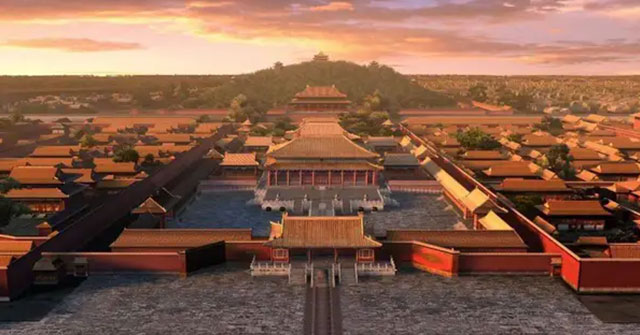Decipher the name 'Forbidden City' of the Imperial Palace: The wall is red with yellow tiles but uses the word 'zi' to mean purple?
The Forbidden City is the Royal Palace of the Ming and Qing dynasties (China). The first impression of those who come here to admire or see on pictures of the Forbidden City is the red wall with yellow tiles.
The Forbidden City, or the Palace today, has more than 9,000 large and small rooms, surrounded by a red wall more than 10 meters high.
Everywhere in the Palace, there are dazzling red colors, so why is it called "Forbidden City"?

In Chinese, the "zi" in the Forbidden City is purple. Many people wonder why not use the word "chain" or "pink" (with the same meaning in red) to name, but use the word "death" with an unrelated color!
According to research, the "death" in the Forbidden City here is not only color, but also authority and solemnity.
Forbidden City means forbidden ground of the Imperial Palace. Purple represents the stars, the light of the stars in the sky, not the simple purple color people think.
So why are the walls in the Imperial Palace mostly red? Because red harmonizes with gold - the color of the ancient Chinese imperial family. All combined into a lavish, magnificent city, the most prominent in the land of the capital, and equally dignified, making people tremble and submit.

Few people know that the "death" in the Forbidden City also has the meaning from the idiom "death gas east hybrid".
The way to say "zi qi Dong Lai" is an idiom derived from the legend of Lao Tzu before going through Ham Coc Quan, also known as Ham Coc Pass. At that time, Doan Hi saw a purple aura (death energy) appearing from the east, knowing that a saint would cross the pass. Sure enough, Lao Tzu riding a buffalo appeared in the east. The ancients believed that this was a sign of good luck and auspiciousness. Since then people use "hybrid death qi" to talk about luck.
Ham Coc Quan is a strategic pass, between the route separating the Hoang Ha and Vi Ha river valleys - the cradle of Chinese civilization and home to the ancient capital of many emperors, Xi'an. It is located on the south bank of the Yellow River, to the east of Erdasi at the head of Tongguan, Shaanxi.
At the same time, the "zi" in the Forbidden City is also a symbol of the highest honor and status of the Royal Palace.
It is known that materials with purple ingredients at that time were extremely expensive. To dye purple for fabrics, it has to go through many difficult processing stages. Therefore, not everyone can buy and wear purple clothes. At that time, many high-ranking officials chose purple because it symbolized high status, nobility and wealth.
Therefore, the name Forbidden City has no meaning derived from the color alone, nor because the color is beautiful, so the name is used, but purely because of the deeper meaning. This shows the erudition and depth of thought and knowledge of the ancient Chinese.
The presence of the Forbidden City is the ultimate power of the Ming Dynasty - Qing Dynasty. The rules were extremely strict, so it was difficult for ordinary people to approach the Royal Palace. Only a few literary and martial great officials could enter and exit the palace to rise to the high court and discuss the major issues.
- Decoding the architectural mystery to help the Forbidden City 'special treatment' of 200 earthquakes
- Revealing the secret of building the Forbidden City
- 4 periods of heavenly action in the Forbidden City
- The Forbidden City has a place that is cold all year round
- The Forbidden City - China
- The 'treasure' on the Forbidden City gate has money that cannot be changed: No one touches it for posterity!
- The king's murder made the center of the Forbidden City clear of trees
- The mystery in the harem of the Forbidden City
- Learn the origins of cotton bricks 'classics'
- Mysterious 3 'weird' deaths by dragon chairs in the Forbidden City
- There were 9,999 rooms, why didn't Forbidden City have only one toilet?
- Treasure beneath the underground Forbidden City: Can buy all Europe
 Biography of hero Vu A Dinh
Biography of hero Vu A Dinh History of hematology
History of hematology Who is Mr. Tam Da 'Phuc-Loc-Tho' and what does it mean?
Who is Mr. Tam Da 'Phuc-Loc-Tho' and what does it mean? Unbelievable facts about the history of the oil and gas industry: Gasoline used to be cheaper than water, so abundant that it had to be dumped into the river...
Unbelievable facts about the history of the oil and gas industry: Gasoline used to be cheaper than water, so abundant that it had to be dumped into the river... 4 periods of heavenly action in the Forbidden City
4 periods of heavenly action in the Forbidden City  There were 9,999 rooms, why didn't Forbidden City have only one toilet?
There were 9,999 rooms, why didn't Forbidden City have only one toilet?  Decoding the architectural mystery to help the Forbidden City 'special treatment' of 200 earthquakes
Decoding the architectural mystery to help the Forbidden City 'special treatment' of 200 earthquakes  Not the apple, 'The forbidden fruit' Adam and Eve ate in the Garden of Eden is what fruit?
Not the apple, 'The forbidden fruit' Adam and Eve ate in the Garden of Eden is what fruit?  Revealing the secret of building the Forbidden City
Revealing the secret of building the Forbidden City  The Forbidden City - China
The Forbidden City - China 